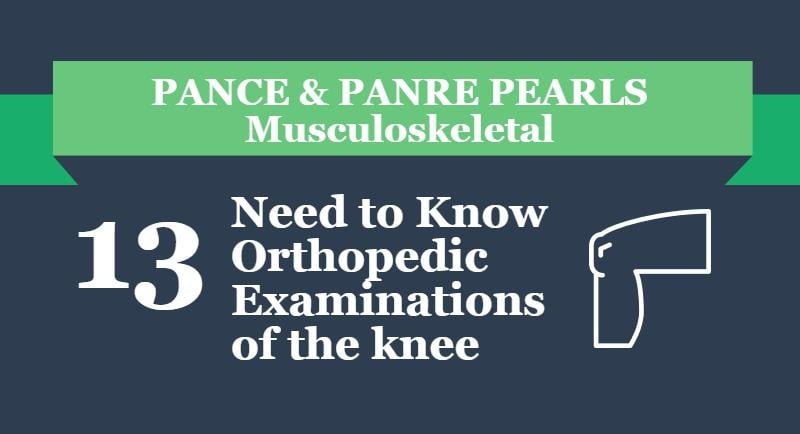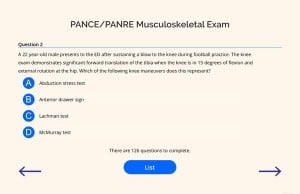The NCCPA™ Musculoskeletal Content Blueprint covers 3 general disorders of the knee
Below are the most commonly referenced special examinations of the knee that you should know for your examination.
*click the links below to view a video demonstration of the orthopedic exam in a pop-up window
Meniscus
Thessaly Test: Check for tear of medial or lateral meniscal tear
- Have patient hold your hand and have patient stand on one leg with knee flexed to 20 degrees, then patient will internally and externally rotate their knee
- 90% sensitive, 96% specific
- (+) if pain or locking/catching sensation
McMurray Test: Check for tear of medial or lateral meniscal tear
- Repeated passive flexion and extension of knee
- Grasp patient’s heel with one hand and place fingers and thumb of other hand along joint line; passively flex knee and internally rotate tibia; extend the knee while maintaining internal rotation; passively flex the knee while externally rotating
- Sensitivity: 50%, specificity 60-97%
- (+) if painful click in early or mid extension of the knee
Apley Grind Test: Check for tear of medial or lateral meniscal tear
- Patient prone with affected knee flexed 90 degrees, stabilize thigh with a knee or hand; press patient’s heel toward the floor while internally and externally rotating the foot
- Sensitivity: 38-41%
- (+) if pain with grind, no pain with distraction (pain with both suggests ligament injury)
Anterior Cruciate Ligament (ACL)
Lachman Test: Check for ACL tear or laxity (GOLD STANDARD)
- Knee flexed at 20 degrees, stabilizing the distal femur with one hand and pulling forward on the proximal tibia with the other hand
- (+) if abnormal forward mobility
Anterior Drawer Test: Check for ACL tear or laxity
- With the patient supine and the knee flexed to 90 degrees (hip flexed to about 45 degrees), the foot is restrained by sitting on it and the examiner's hands are placed around the proximal tibia. Then, while the hamstrings are felt to relax and the tibia is pulled forward, the displacement and the end point are evaluated.
- (+) if abnormal forward mobility
Pivot Shift (Losee) Test: Check for ACL tear or laxity
- A valgus and internal rotation force is applied to the tibia; Starting at 45 degrees of flexion, the lateral tibial plateau is reduced. Extending the knee causes the lateral plateau to subluxate anteriorly with a thud at about 20 degrees of flexion. It reduces quietly at full extension
- (+) if feel clunking of tibia when moving into extension
Posterior Collateral Ligament (PCL)
Posterior Drawer Test: Check for PCL tear or laxity
- It is performed with posterior pressure on the proximal tibia with the knee flexed at 90 degrees and
- (+) if abnormal downward mobility
Posterior Sag (Godfrey) Test: Check for PCL tear or laxity
- This test involves flexing the knee and hip and noting the posterior pull of gravity creating posterior “sag” of the tibia on the femur
- (+) if depression on anterior knee
Dial Test: Check for PCL tear or laxity
- Externally rotate each tibia and note the angle subtended between the thigh and the foot. The dial test is performed at 30 and 90 degrees of flexion with a significant difference being an angle 5 degrees or greater than the contralateral leg.
- Injury to the posterolateral capsule alone is confirmed with greater external rotation at 30 degrees, an isolated PCL at 90 degrees, and to both structures when there is greater rotation at 30 and 90 degrees compared to the uninjured leg
- (+) if abnormal motion of tibial tubercle
Medial Collateral Ligament (MCL) and Lateral Collateral Ligament (LCL)
Valgus stress test: Check for MCL damage
- Patient with knee in 20-30% of flexion, apply valgus stress to knee
- (+) if pain, gaping and or opening with endpoint or no endpoint
Varus stress test: Check for LCL damage
- Patient with knee in 20-30% of flexion, apply varus stress to knee
- (+) if pain, gaping and or opening with endpoint or no endpoint
Tests for effusion
Ballottement test: Check for major effusion in knee joint
- Squeeze fluid down from above knee and feel on either side of patella for fluid
- (+) if fluid felt
Bulge sign: Check for major effusion in knee joint
- Squeeze fluid up medially, then tap laterally and watch for medical bulge
- (+) if fluid felt
This is from the PANCE Blueprint Musculoskeletal Course (10%)







